Plastics are everywhere because of their versatility, longevity, and simpler manufacturing requirements. Plastic extrusion, along with injection molding, is one of the most common processes for high-volume production. Generally, extrusion is common for continuous profiles that use pipes, tubes, door profiles, and other bulky items.
Industrial applications of plastic extrusion started over a century ago and continued to advance with time. Even today, it is the go-to method for many plastic manufacturing projects because its simple, efficient, and delivers accurate results.
The following text takes a look at the basics of the plastic extrusion process. Its advantages, limitations, types, and finally the common applications across different industries.
An Overview of Plastic Extrusion
Plastic extrusion is a process where granular pieces of plastics go through different components of the extruder to end up in a continuous profile with the help of heat and pressure. To understand the process better, it’s important to first understand the extruder and how it works.
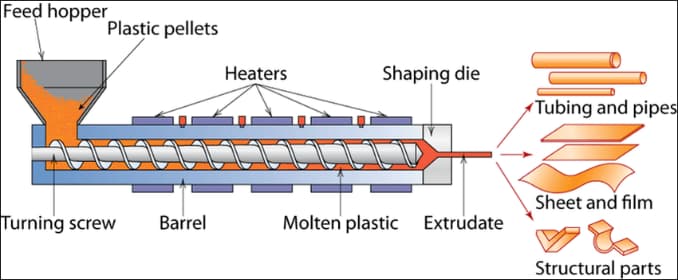
The above picture is a common plastic extruder that has the following components:
- Hopper: This is the first stage of the plastic extruder. Hopper stores the plastic in granulates and keeps it ready for the next stage of the process.
- Feedthroat: The feed throat directs the coming plastic from the hopper towards the barrel.
- Breaker Plate: This component acts as a filter for the barrel and helps maintain the pressure
- Barrel: This is a heated component that softens the plastic and takes it close to the melting point. Moreover, the rotating screw in the barrel forces the material to the feed pipe.
- Feed pipe: Acts as a conduit for the molten plastic coming from the barrel
- Die: This is the rigid metal part through which the material is pushed to get the desired profile.
- Cooling System: Finally, the last stage where the extrusion profile solidifies through rapid cooling.
How Does Plastic Extrusion Work?
The plastic extrusion process begins with filling the hopper with smaller plastic pieces that are simpler to process. The feed throat uses gravity to transfer that plastic to the barrel for further processing.
When the material enters the barrel, it starts to be warmed by means of at least three intensity zones, where the temperature intensity increases as you move away from the feed throat.
As the temperature increases, the barrel uses a continuously rotating screw to push the molten plastic towards the next component of the machine. The screw and pressure additionally create heat, so the intensity zones themselves don’t need to be basically as hot as the expected extrusion temperature, thereby saving energy and facilitating the extrusion process.
The liquid plastic leaves the barrel through a screen supported by the breaker plate. This screen eliminates foreign substances from the material and maintains the internal pressure. The material goes through a feed pipe into the uniquely fabricated die, which has the same shape as the extrusion profile you want from the project.
At the point when constrained through the die, the molten material creates the same shape as the die opening, which completes the extrusion process.
When completely through the die, the extrusion profile is cooled in a water shower or by means of a bunch of cooling rolls to ensure that the shape of your thermoplastic extrusion profile becomes permanent.
Plastic Extrusion Through the History
Extrusion has always been a high-volume manufacturing process. It started in Germany when Paul Troester created the first plastic extruder. Since then the fundamentals of the process haven’t changed much.
However, there is a lot of improvement in the process when it comes to its efficiency and material handling capabilities. In the past, extrusion machines could only handle specific types of plastics and had many requirements. With time, this improved, and today, plastic extrusion is more versatile, flexible, and capable of handling different kinds of plastics together.
Another common problem with extruded plastics is the fact that they don’t possess the right mechanical properties and strength. This was a significant problem in the past but new developments in technology improved things. Today, custom plastic extrusion is the go-to process of choice as it delivers the quality, consistency, and functionality you expect from modern industrial applications.
Different Types of Plastic Extrusion Processes
The type of extrusion process you deal with depends on the die shape. While the fundamental process of plastic extrusion remains the same, the different types of processes allow you to efficiently deal with the complexities and intricacies of dealing with different shapes.
Here are the 4 main types of plastic extrusion processes that the industries use today.
1 – Tubing Extrusion
This process is for long tubes, pipes, and other similar items. Generally, processing hollow equipment becomes more difficult. Despite this, this extrusion process remains the same till you reach the die. At that stage, the process uses positive internal pressure to overcome the higher power requirements of dealing with hollow parts.
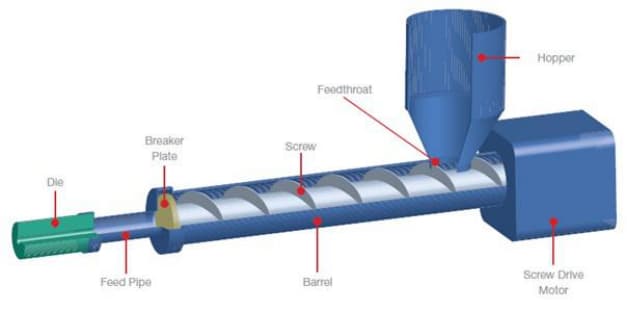
2 – Blow Film Extrusion
The blow film extrusion process is quite common as it creates many everyday items like shopping bags and other packaging materials. Once again, the process is just like any other type of extrusion (like the aluminum extrusion process). However, the main difference is in the die stage where the material goes through cooling before leaving the die.
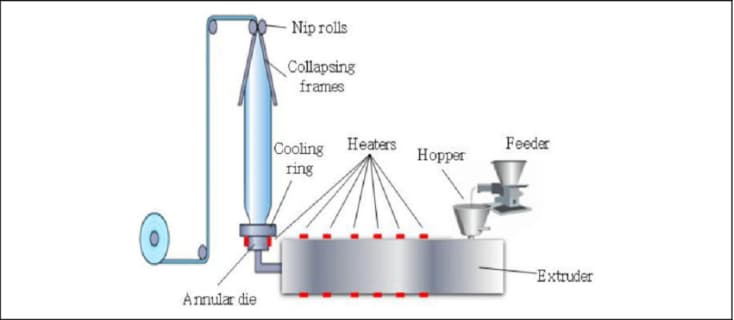
At that stage, the material doesn’t solidify completely. That’s why it later goes through an additional process of expansion through blowing. The process is only limited to thinner plastic films. For thicker sheets, you’ll have to go through some other process.
3 – Sheet Film Extrusion
This process is very similar to the aforementioned blow film extrusion. However, it’s for workpieces that are too thick for blowing. In that case, the material goes through a pulling and rolling process to get the shape you need.
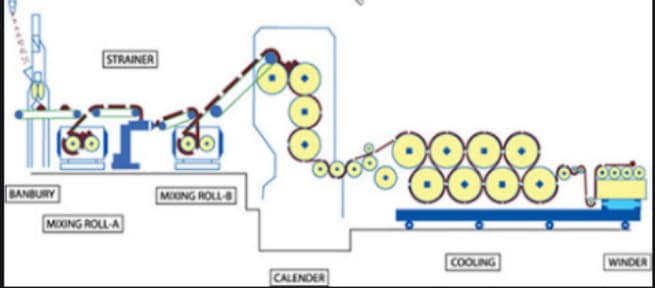
The rolling process also cools down the plastic and allows it to solidify permanently. Generally, this process allows you to create ice cream boxes, juice cartons, wine boxes, and other thicker plastic packaging easily.
4 – Over Jacket Extrusion
The next type of extrusion is for insulation wires and other similar applications where you cover something entirely with plastic. The process is simple. You pull the material that needs the coating through the die to give it a plastic cover.
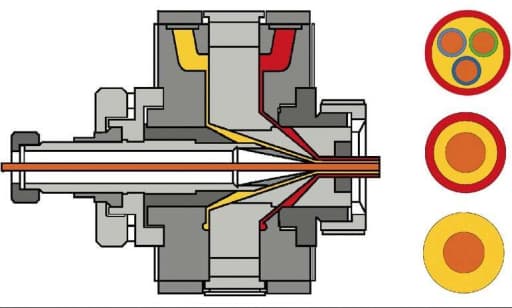
Depending on your requirements and application, you might need adhesion between the plastic and the material as well. In that case, all you need to do is to use pressure tooling. This simple addition applies enough pressure on the material to offer excellent adhesion that lasts for a long time.
Types of Plastic Extruders
If you are thinking of investing in a plastic extruder, you’ll have the option of going with either a single screw or twin-screw extruder. Both devices have the same capability to perform all the processes discussed before. However, the type of extruder can affect your production speed, mixing capability, and overall flexibility of operations.
Here are the details of what each kind of extruder brings to the table.
Single Screw Extruder
As their name suggests, single-screw extruders are simple contraptions with one rotating screw in the barrel. Generally, single-screw extruders are ideal for situations where you need simple profiles like pipes and sheets. While single screw machines work quite well, they are a bit slow, don’t mix well, and may not be the best choice for any complicated shape.
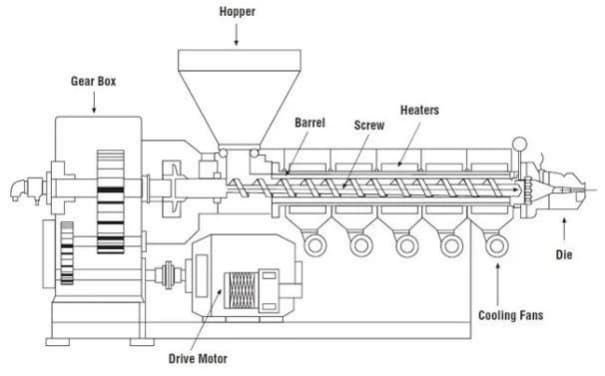
Twin Screw Extruders
As their names suggest, twin-screw extruders have parallel screws in the barrel. Depending on the application, the twin screws can rotate in the same direction or different ones. Because of their design, twin-screw extruders offer greater stability, exhaust performance, speed, and mixing performance.
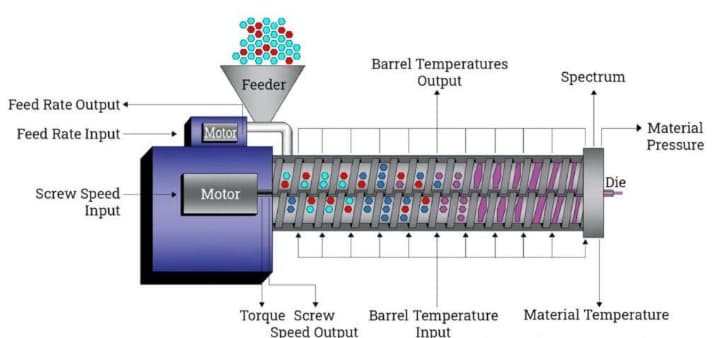
Advantages of Plastic extrusion
Extrusion is a popular high-volume production method that offers the perfect combination of versatility, flexibility, and consistency. Here are some of the main advantages of the extrusion process for plastic.
- Cost-Effectiveness: When compared with other processes, extrusion is quite cost-effective. Generally, plastic parts are developed with either injection molding service or extrusion. However, extrusion doesn’t have elaborate tooling requirements and is much simpler, resulting in lower costs. Moreover, extrusion machines can also run continuously without any breaks, which offers 24-hour manufacturing to reduce the chances of inventory shortages.
- Unparalleled Flexibility: As long as there is a consistent cross-section, you can create any shape or profile with the plastic extrusion process. From complex shapes to sheets, pipes, and other products, extrusion can deliver almost all kinds o designs.
- Alterations: Before the cooling process, hot plastic remains quite malleable. This means that you can easily perform other shaping operations to make sure that the final product is of the size you need.
The Main Applications of Plastic Extrusion
As one of the main methods of creating plastic parts, the overall applications of the extrusion process are too widespread. However, the following are some of the most prominent areas where plastic extrusion technologies play an integral part.
Pipes and Tubes
Pipes and tubes are among the most common plastic extrusion products. The die requirements are also the simplest as the only thing you need is a simple cylindrical profile. PVC pipes are also extremely common in the industry but you can find other alternatives as well. Whatever material you use, there are high chances that pipes and tubes went through plastic extrusion.
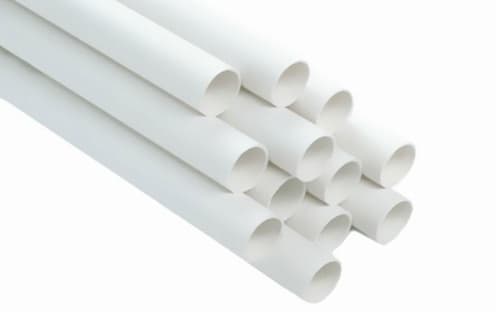
Wire Insulation
Plastics naturally have excellent electric insulation properties. Moreover, their natural flexibility and thermal stability make them a perfect choice for insulating live wires and jacketing. Generally, most jacketing and insulation work uses the extrusion process as it’s the easiest and offers long-lasting results.
Windows
Window frames are another common application of extruded plastics. Many people use PVC for that purpose because it lasts a long time and has a natural resistance to UV radiation from the Sun.
Doors
Just like the windows, door frames are another common application of extrusion because of their continuous profile and constant cross-section. Once again, PVC is quite popular when it comes to door frames and other household fittings because of its stability and superior mechanical characteristics.
Blinds and Shades
This is another classic example of how common extrusion is. Blinds and shades often have multiple identical slots that combine for functionality. Extrusion of Polystyrene, a popular plastic choice can give you the faux-wooden look that you often see in common blinds.
Cleaning Equipment
Wipers, squeegees, and other cleaning equipment use plastics for their handles. Some products even have a rubber-like plastic that offers better cleaning and you need extrusion to create them in high volumes.
RapidDirect: The Best Choice for Quality Plastic extrusion Services
Plastic extrusion is a common choice because of its relative simplicity, cost-effectiveness, and versatility. However, that doesn’t mean that anyone can get started with the process. The extrusion technologies have multiple pre-requisites, design requirements, and other important considerations that ensure consistent results. Moreover, you also need to invest in multiple types of equipment and other setups to get started.
For small to medium businesses, investing so much time and resources is impractical. For them, a comprehensive and experience extrusion service like RapidDirect is the best choice.
At RapidDirect, we aim to be more than just a simple service provider. We are a one-stop shop for all your manufacturing needs starting from the designing phase to the optimization. We have the latest machinery and the most experienced team to deliver the best combination of quality, reliability, and performance in the shortest time possible.
One thing that sets RapidDirect apart is the complete online quotation platform. We have the most advanced system that delivers you an immediate quotation for your project.
Simply add your designs and other specifications for the project and we will get back to you with the expected costs to get started. Not only that, but we also offer a free Design for manufacturing (DFM) report to help you optimize your design and streamline the entire process for the best results.
Bonus: Plastic vs Aluminum Extrusion
Extrusion is not limited to plastics only. You can use the process for metal parts with a continuous profile as well. Generally, Aluminum is one of the most common metals that goes through the extrusion process because of the material’s strength, density, recyclability, and other mechanical characteristics.
Today, Aluminum extrusion is a common manufacturing process that creates products like bars, tracks, pipes, heatsinks, and numerous other items. Generally, the requirement of your material having a continuous profile and an even cross-section holds true in the case of Aluminum as well.
Moreover, an important distinction between the plastic extrusion process and Aluminum extrusion is the temperature.
Unlike plastics, Aluminum extrusion can be both hot and cold. Cold extrusion generally delivers materials with high strength but requires more power. Contrarily, hot extrusion takes place between 350oC to 500oC, which becomes easier to process but at an expense of the mechanical properties.


